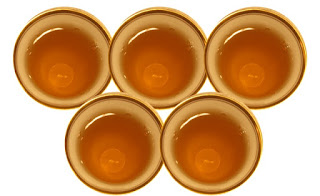 |
| Five cups of tea |
On
my recent trip, I learned about a new gold-medal tea coming out of
Taiwan—just in time for the commencement of the Track and Field
Olympic Trials in Eugene, Oregon, aptly known as “Track Town USA.”
Does tea really make you run faster, jump higher, or throw further?
It just might.
Competitive
theories aside, the release of this new tea is due in large part to
China's demand for Taiwan's competition-winning tea. China's economy
is strong and China has a gift giving culture; tea is one of the most
common gifts given in China. Taiwan has revolutionized its
relationship with China, creating direct flights, postal service and
new shipping routes between Taiwan and the mainland. With China's new
found wealth, the trend in gifting is that it should be big and it
should be the best, making Taiwanese competition winning tea an ideal
choice. But this recent trend has people in Taiwan's tea industry
talking.
“They
don't want toudeng
first through tenth, they want regular toudeng,”
said He Lao, an artist and tea culture expert. He and many other
Taiwan tea industry insiders are surprised by this because everyone
in Taiwan's tea world knows that tedeng
is first place. Toudeng
first through tenth come next (ranking second through eleventh) and
then comes toudeng,
the remaining teas in the first-tier. “In the mainland, they don't
like 1-10 because it implies that there is something else, or there
could be something better. They just want the one that says 'the
best',” he explained. Toudeng
is still considered excellent tea by tea experts in Taiwan and
throughout the world.
Traditionally,
teas ranking below toudeng
are categorized as erdeng,
or
second-tier. Second-tier is by no means inferior tea. It is still
considered to be some of the best, and ranked in the top three. Such
high quality tea rarely makes it to the U.S. and is only handled by
very specialized vendors. Due to the overwhelming demand for tea
that is considered “the best” some competitive ranking
organizations have taken the leap, changing what was formerly known
as second-tier ranked tea, to “jing
pai” or
gold- medal winning tea. Let's face it, “gold medal winner”
sounds a lot better than “second-tier.”
The
organizations that oversee and hold the competitions to rank teas are
fighting it out—for sales. And, this is not the first time the
organizations have changed the naming system. Two well respected
organizations based in Nan Tou, known as He
Zuo Shi and
Lugu
Nong Hui, battled
it out years ago—in plum flowers. One organization boasted three
plum flowers on their packaging, as an indicator of high quality; not
be outdone in floral decorations, the other added five plum flowers
to their packaging. Thus, we dissolve into the minutia of Taiwan's
Olympic rings of tea. This all reminds me of what my amazing
grandmother, Lisl Waechter, used to say, “I just don't
understand...why everyone is trying to be the best?” In fact, these
teas are quite spectacular on their own, gold medals and plum flowers
aside.

No comments:
Post a Comment